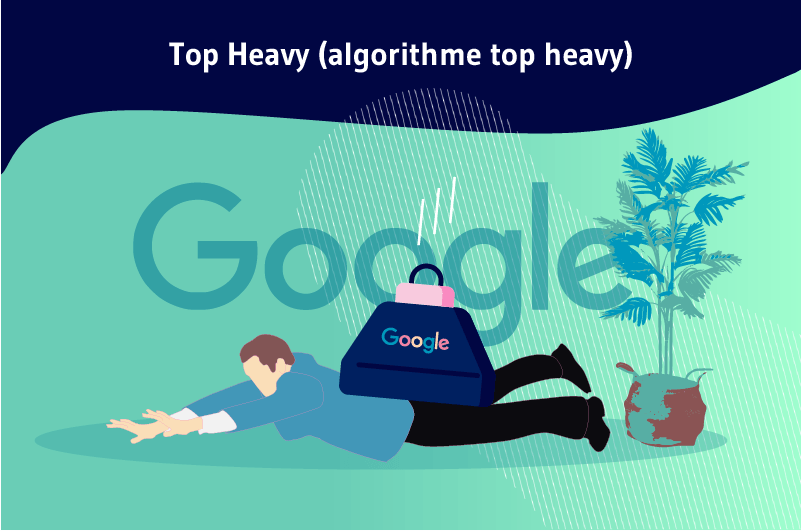The term ”Top heavy” refers to the update of the layout algorithm adopted by Google. It was primarily aimed at penalizing the ranking of sites that displayed a lot of ads above the main content.
Google is constantly and tenaciously updating its algorithm, which continues to change the way content designers and producers approach their respective businesses.
One of the most notable changes Google has made is the ”Top Heavy” update, which penalizes sites that make their content more difficult to access.
The goal is to facilitate the consumption of information to the visitor by providing relevant content immediately at the top of the page.
In this article we will mainly talk about :
- What is the Top Heavy update;
- And the right ways to present relevant content above the waterline.
So follow along!
[knock]
Chapter 1: What does Top heavy mean?
In this chapter, we’ll just answer a bunch of questions to help you understand the background of this change.
1.1) What is Top Heavy?
The Top Heavy update focuses specifically on the user experience affected by heavy ads above the main content of a page.
In its post on its Inside Search blog, Google informs its audience about the update:
”We’ve heard complaints from users that if they click on a result and it’s hard to find the actual content, they’re not happy with the experience. Rather than scrolling past a multitude of ads, users want to see the content immediately.”
This would mean that sites should start by providing value to the user from the top of the waterline
That is, it doesn’t make for a good experience if the top of the fold remains empty or cluttered with other things that have no bearing on what brought the reader in.
But to be more specific, Google publishes another post on its Google Webmaster Central blog to point out that:
”Sites using pop-ups, pop-unders or overlay ads are not affected by this. This only applies to static ads in fixed positions on the pages themselves, Google told me.”
Like other updates from the web giant, the ”Top Heavy” update has impacted many websites online
1.2. how does the ”Top heavy” update work?
If you have a site, it is very natural to run ads for a little extra income.
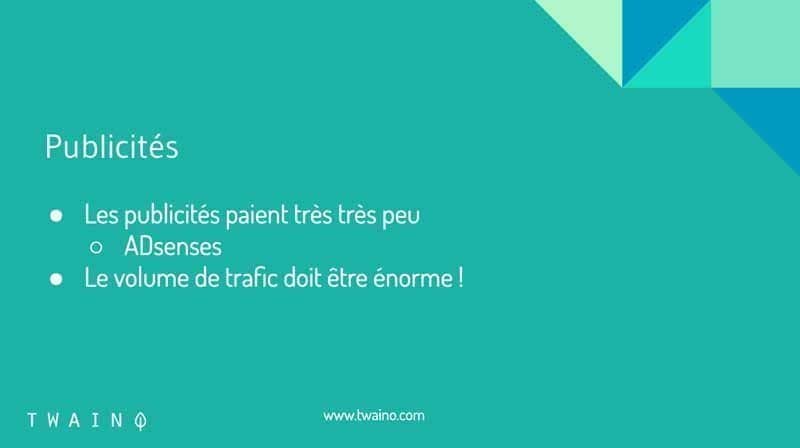
By the way, Google has a platform, AdSense, which displays ads on your site targeted to your specific audience
Because the ads are right at the top of your page, visitors can see them, click on them and you will be rewarded.
This has become a very recurring and abusive practice for most website owners.
Since Google is very keen on providing a top-notch experience, it initiated the Top heavy update to penalize these behaviors.
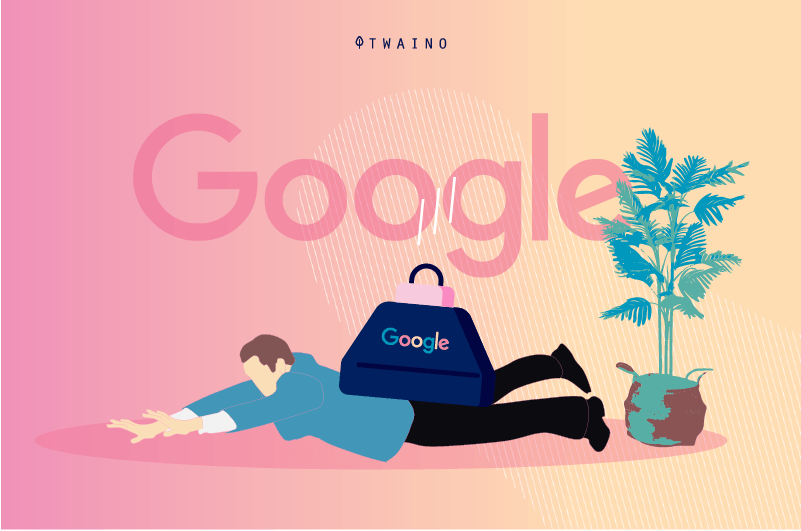
According to figures, the Top Heavy update had only affected less than 1% of all global searches when it was introduced.
The goal is to make it easier for users to get to the content they are looking for to be driven to your website.
Whether you use AdSense or another platform, you need to make sure your ads are not so concentrated at the top of your pages that they prevent users from easily seeing your content.
1.3. What is the timeline for the Top Heavy update?
Like any other filter, the Top Heavy algorithm went through several updates after its initiation. Here is a timeline:
Layout algorithm launch on January 19, 2012: This is the heaviest algorithm change that targeted exaggerated ads placed above the waterline. It is also known as the ”above the waterline algorithm” or ”top heavy” update that was implemented to make sites care more about the layout of their site. However, this first rollout only affected less than 1% of all searches.
Layoutalgorithm update on October 9, 2012: The purpose of this update was to adjust the algorithm and allow sites affected by the first update to recover if they eventually made the corrections.
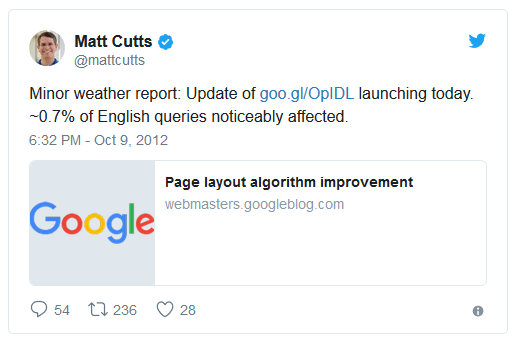
Source : mediastreet
We note that this update has affected only 0.7% of all English searches.
Layout algorithm update on February 6, 2014: On this date, Google made an update to the layout algorithm. This allowed Google’s algorithm to update its index.
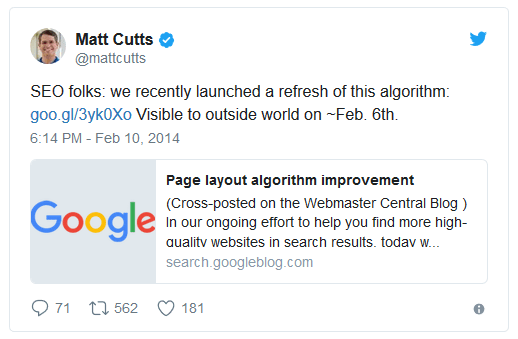
Source: mediastreet
But, the numbers were not known to the public after this update. This is the top Heavy 3.
Automated layout algorithm on November 1, 2016: With this automation, Google took into account the changes made by the website to get the ranking
In a video of a few tens of minutes, John Mueller of Google remains specific about this update:
”It’s pretty much automatic in the sense that it’s probably not live, one-on-one. We would just like to call it back, so we know exactly what it looks like. But it’s something that’s updated automatically. And it’s something where when you change those pages, you don’t have to wait for a manual update on our end for it to take effect.”
Thus, it is understandable that Google started by taking into account changes to sites to automatically adjust rankings after crawling a site.
Chapter 2: What are the best practices to adopt?
In this chapter, let’s look at how you can maintain your website to avoid Google Top Heavy penalties.
2.1. keep a good balance between ads and content
The top of the fold quite loaded with ads can be a signal of carelessness and irrelevance in the eyes of users.
When they see this, they probably won’t continue down to find the main content, they will leave.
It is therefore essential to ensure a balance between the content of the page and the ads placed on top of it.
That way, the reader won’t have to scroll too far to discover the content they arrived on the site for.
2.2. Check your ad/content ratio
With tools like Google Analytics, you can determine if you have enough relevant content above the waterline to engage visitors
This also allows you to check view counts to see which ads you should remove if necessary.
2.3. follow Google’s recommendations on ad placement
Having an advertising platform called Adsense, Google is supposed to provide guidelines that frame how web marketers should run ads on their sites always keeping a better user experience.
Generally speaking, here are a few points of the practices to adopt:
- Google has provided a list of rules for webmasters globally in its ”guide for webmasters” and specifically for ads in its ”Adsense program”. To avoid being impacted by the top heavy update, it is a must to respect these rules;
- Avoid cheating practices such as clicking on your own ad and asking your relatives to do the same to have a high click rate. Another one of these practices is using programs to acquire more traffic on the advertising pages. Avoiding them will help your site avoid Google penalties;
- Publish content that is relevant to your target audience. Either way, you will make money if your content appeals to readers, as it will prompt action;
- It is imperative to optimize your website for SEO and provide informative content in order to attract more leads, as this is the most honest and least expensive way;
- Make your website or blog responsive enough. The responsiveness of your website means that you will cover a large number of users, as it can adapt to mobile devices which are the most used ways to access the internet. In addition, a responsive site can allow your users to be able to view your ad in its normal size on all devices ;
- It is also not enough to place your ads to attract people, but you need to know where to place them. For this, it is advisable to conduct a placement test to see the place that helped you generate more clicks. It would still be good to test the standard sizes (300 × 250, 728 × 90 and 160 × 600) in the ”Above the fold” section first;
- Increase your chances by placing the ads in the main locations. For example, ads placed in the ”Above the fold” section are more visible to visitors without scrolling down. On the other hand, ads in your leaderboard under your header/logo are even more likely to bring in clicks because it’s right at the top of the page. And ads in your content are also often a winner, because it’s exposed to readers as they read the content they’re on the page for;
- Measure your performance. Google provides its users with free tools to track the progress of campaigns on their websites. You should use them to see if your strategies are working;
- One last thing you should stick to is checking Google’s email messages. These messages often contain suggestions or warnings about certain situations.
2.4. Optimize content above the waterline
It’s a good idea to have quickly consumable content above the waterline, but it’s even more ideal if it’s optimized.
With that, here are some points of guidance:
- Keep the top fold only for vital, high-priority information that really provides value to visitors;
- You really need to make visitors feel like they are above the waterline by placing information that deserves to be there. Readers should find information that is waiting to be seen in the footer immediately from the beginning in the above the fold section;
- Reduce the visitor’s interaction cost, that is, the mental and physical effort required to interact with your content. Information that is easily visible will have a low interaction cost. Hidden information has a higher interaction cost, both the mental effort to determine if there is more information to consume and the physical effort to access it
With that in mind, here are the content elements above the waterline that you should prioritize:
- Unique Selling Proposition (USP): This is basically what will make it clear to them what you’re offering and how it will benefit them ;
- Lead Copy: This brief introductory paragraph builds on the USP and explains what the product you are offering does to customers. It convinces the visitor to scroll down to the secondary copy below the fold;
- Branding: Branding is usually the best opportunity to stand out with your brand elements such as logo, font and brand colors;
- Navigation: This gives them the opportunity to explore the site further through relevant touch points that are simple and easily visible;
- Your contact information: This builds trust in the minds of visitors and shows them that you are a credible company;
- A call to action: Since your content above the waterline isn’t always conversion-focused, you can choose whether or not to add a CTA depending on your audience and purpose.
Conclusion
As can be noted, the ”Top Heavy” update is also, like others, a filter that focuses on user experience.
This update calls on web marketers to reduce ads above the waterline and provide good content immediately consumable to users in this section.
We have detailed in this article the concept of Top Heavy and the right ways to avoid Google penalties.

